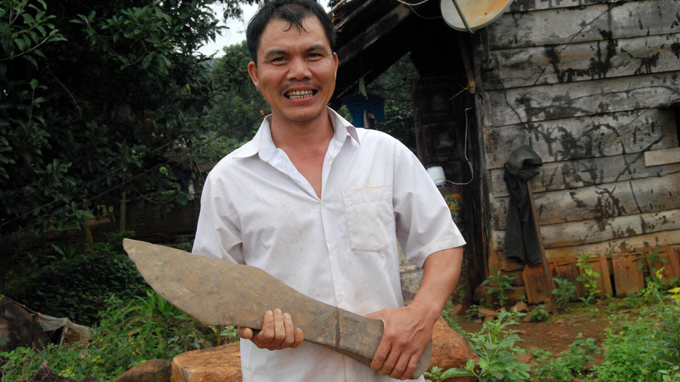Nguyen Van Hung, a poor farmer in the Central Highlands province of Gia Lai, has been collecting thousands of millennium-old antiques over the past 10 years. His treasured collection is of tremendous value to research on the prehistoric civilization in the area.
Hung’s shed-like, 40m2 house, shabbily built from iron sheets and located in a remote corner of Chu Prong town, is filled to the brim with antiques.
“I’ve spent most of my earnings on buying antiques and save only a little for my kids. My wife does most of the farming,” said 43-year-old Hung, who has a limited education.
Hung’s most cherished antiques are stone and bronze items which belong to the prehistoric age. He bought them from local ethnic minority people as well as the Kinh people in the lowlands for high prices.
“The pieces are really illuminating, they teach me how prehistoric people lived thousands of years ago and help archeologists understand the past,” shared Hung.
The farmer’s antiques come in a wide variety of shapes, sizes, and materials, ranging from stone tools and objects for worship to items solely for decoration and bronze statues.
As his house is too small, Hung has no choice but to heap many of his treasured antiques into piles.
During his 10 years collecting antiques in Chu Prong, Hung said he has found dozens of sites likely to have been prehistoric tool making workshops, located by the springs in the area.
He has also painstakingly gathered sacks of small stones left over from the tool making process to help with archeologists’ research and inform locals of the ancient art of tool making.
One of Hung’s constant concerns is his lack of financial support to continue his search for more ancient antiques in the area while they may be getting damaged or buried by natural calamities and modern construction projects.
Over the past 10 years, though he has taken up another job as a stone worker at local mines, Hung and his wife have been struggling to make a living and provide for their children.
“I hope to receive some help from the local government to expand my current house and make it more accessible to visitors. I’m positive that if so, many will come and take a look at my prized collection,” Hung shared.
After personally exploring Hung’s collection, Phan Thanh Toan, an authority on the Stone Age from the Vietnam Archeology Institute, introduced the collection at a local archeology seminar in Sept 2013. The expert highly values Hung’s collection, which dates back to the late Stone Age and the early Bronze Age some 4,000-3,000 years ago and spans across various momentous historical periods.
According to Toan, the artifacts found in Chu Prong bear a remarkable resemblance to the Tai Per culture group and also have some connections with the Lung Leng archeological site in neighboring Kon Tum province, which he and his colleagues have conducted research on since 1999.
He also thinks that a set of four bronze mirrors in Hung’s collection are even older than a similar set found dating from the Sa Huynh culture (1,000 BC-late 2nd century AD), one of the country’s three ancient civilizations.
“They weren’t made by natives but brought in from the outside, so they’re really eye-opening, as we haven’t found such exotic items at archeological sites in the Central Highlands for the past decade,” the expert noted.



















































